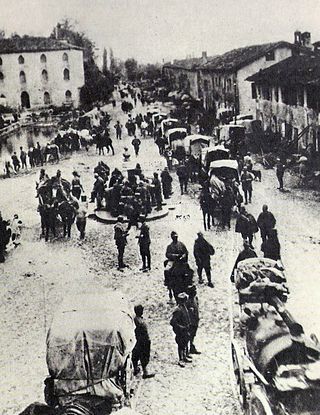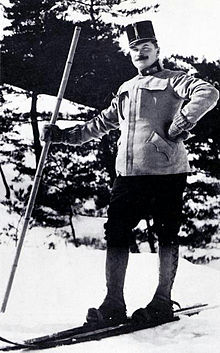
The Austro-Hungarian Army was the ground force of the Austro-Hungarian Dual Monarchy from 1867 to 1918. It was composed of three parts: the joint army, the Imperial Austrian Landwehr, and the Royal Hungarian Honvéd.

Theodor Körner, Edler von Siegringen was an Austrian military officer and statesman of the Social Democratic Party of Austria. He served as President of Austria from 1951 to 1957 and as Mayor of Vienna from 1945 to 1951.

The Military Order of Maria Theresa was the highest military honour of the Habsburg monarchy, Austrian Empire and Austro-Hungarian Empire.

Jōetsu is a city located in Niigata Prefecture, Japan. As of 1 December 2020, the city had an estimated population of 189,430, in 76,461 households with a population density of 190 persons per km2. The total area of the city was 973.81 square kilometres (375.99 sq mi). Jōetsu borders the Sea of Japan and is renowned for its abundance of snow, the annual cherry-blossom festival, sake and Koshihikari rice.

The 13th Division was an infantry division in the Imperial Japanese Army. Its tsūshōgō code name was the Mirror Division, and its military symbol was 13D. The 13th Division was one of four new infantry divisions raised by the Imperial Japanese Army (IJA) in the closing stages of the Russo-Japanese War 1 April 1905, after it turned out what the entire IJA was committed to combat in Manchuria, leaving not a single division to guard the Japanese home islands from attack.

Stjepan Freiherr Sarkotić von Lovćen was an Austro-Hungarian Army generaloberst of Croatian descent who served as Governor of Bosnia and Herzegovina and military commander of Dalmatia and Montenegro during the World War I.

Rudolf Stöger-Steiner Freiherr von Steinstätten was a colonel general in the Austro-Hungarian army and served as the last Imperial Minister for War not only to the Austro-Hungarian Empire but also to the ancient Habsburg monarchy which sat at its head.

Gustav Viktor Josef Globočnik Edler von Vojka was an Austrian soldier and nobleman. He achieved rank of lieutenant field-marshal (Feldmarschalleutnant) in the Austro-Hungarian Army.
The Kaiserjäger, were formed in 1895 as four normal infantry regiments within the Common Army of Austria-Hungary. Despite the name "Tirol" in its title its members were not just recruited from the crown land of Tyrol but also from other parts of the monarchy. The regiments were disbanded in 1918 with the end of the k.u.k. monarchy. The word Jäger is a characteristic term used for light infantry or light infantrymen in a German-speaking context.

Gustav von Myrdacz was an Austrian noble who was instrumental in organizing the Royal Albanian Army from the early 1920s to 1945. He was referred to in Albania as Gustav Mirdashi.

Paul Freiherr Puhallo von Brlog was a general of Austria-Hungary. During World War I, he commanded the Austro-Hungarian Army's 3rd and 1st Armies.

The Battle of Caporetto, took place from 24 October to 19 November 1917, near the town of Kobarid, on the Austro-Italian front of World War I. The battle was named after the Italian name of the town of Kobarid.

The Common Army as it was officially designated by the Imperial and Royal Military Administration, was the largest part of the Austro-Hungarian land forces from 1867 to 1914, the other two elements being the Imperial-Royal Landwehr and the Royal Hungarian Landwehr. However, it was simply known as the Army (Heer) by the Emperor and in peacetime laws, and, after 1918, colloquially called the k.u.k. Armee.

The Imperial-Royal Landwehr, also called the Austrian Landwehr, was the territorial army of the Cisleithanian or Austrian half of the Austro-Hungarian Empire from 1869 to 1918. Its counterpart was the Royal Hungarian Landwehr. The two Landwehrs, together with the Common Army and the Imperial and Royal Navy, made up the armed forces of Austria-Hungary. While the name, "Imperial-Royal", might seem to suggest a link between the "Imperial" (Cisleithanian) and "Royal" halves of the Empire, in this context "Royal" actually refers to the Kingdom of Bohemia - not a sovereign kingdom on par with the Kingdom of Hungary, but a crownland of Cisleithanian Austria-Hungary and possession of the Habsburgs, who remained formally entitled to kingship. In this sense, the Kingdom of Bohemia was comparable in status to the Kingdom of Galicia and Lodomeria and the Kingdom of Dalmatia.

The Imperial-Royal Mountain Troops were founded in 1906 as part of the Austrian Landwehr, the territorial army of the Cisleithanian half of the Austro-Hungarian Empire. As a result, the abbreviation "k.k." was used and not "k.u.k." which would have implied a connexion with the Hungarian half of the Empire.
Adalbert Dani von Gyarmata und Magyar-Cséke was an officer of the Austro-Hungarian Army who served in World War I, holding a number of senior positions, including chief of staff of VI Corps, Army Group Tersztyanszky, and the 3rd Army. Before the conflict began, he had worked in Russia, China, and Japan as a military attaché, becoming an observer during the Russo-Japanese War. It was during that time that von Gyarmata became acquainted with John Pershing, who went on to command the American Expeditionary Force in Europe during the war.
Alfred Edler von Schenk was an Austrian general and later Czechoslovakian government advisor.
Baron Géza Lukachich von Somorja was an Austro-Hungarian military officer and nobleman. He was a lieutenant general in the Austro-Hungarian Army during World War I. Lukacich von Somorja graduated from a military school in Temesvár and upon graduation, he joined an infantry regiment. He progressed through the ranks to Chief of Staff, and later taught at the Maria Theresa Military Academy. During World War I, he fought in Serbia and on the Italian front. For his service he joined the Order of Maria Theresa, received a baronial title and the rank of Feldmarschalleutnant. After the war, he commanded troops garrisoned in Budapest, but was unable to suppress the Aster Revolution. Later in his life, he founded an association of retired military officers, which he led for the rest of his life.

Ludwig Goiginger was an Austro-Hungarian Lieutenant Field Marshal who notably served in World War I.

Georg Bilgeri was an officer in the Austro–Hungarian Army, mountaineer, and Austrian pioneer of skiing. Bilgeri learned to ski in Gargellen about 1893.





















